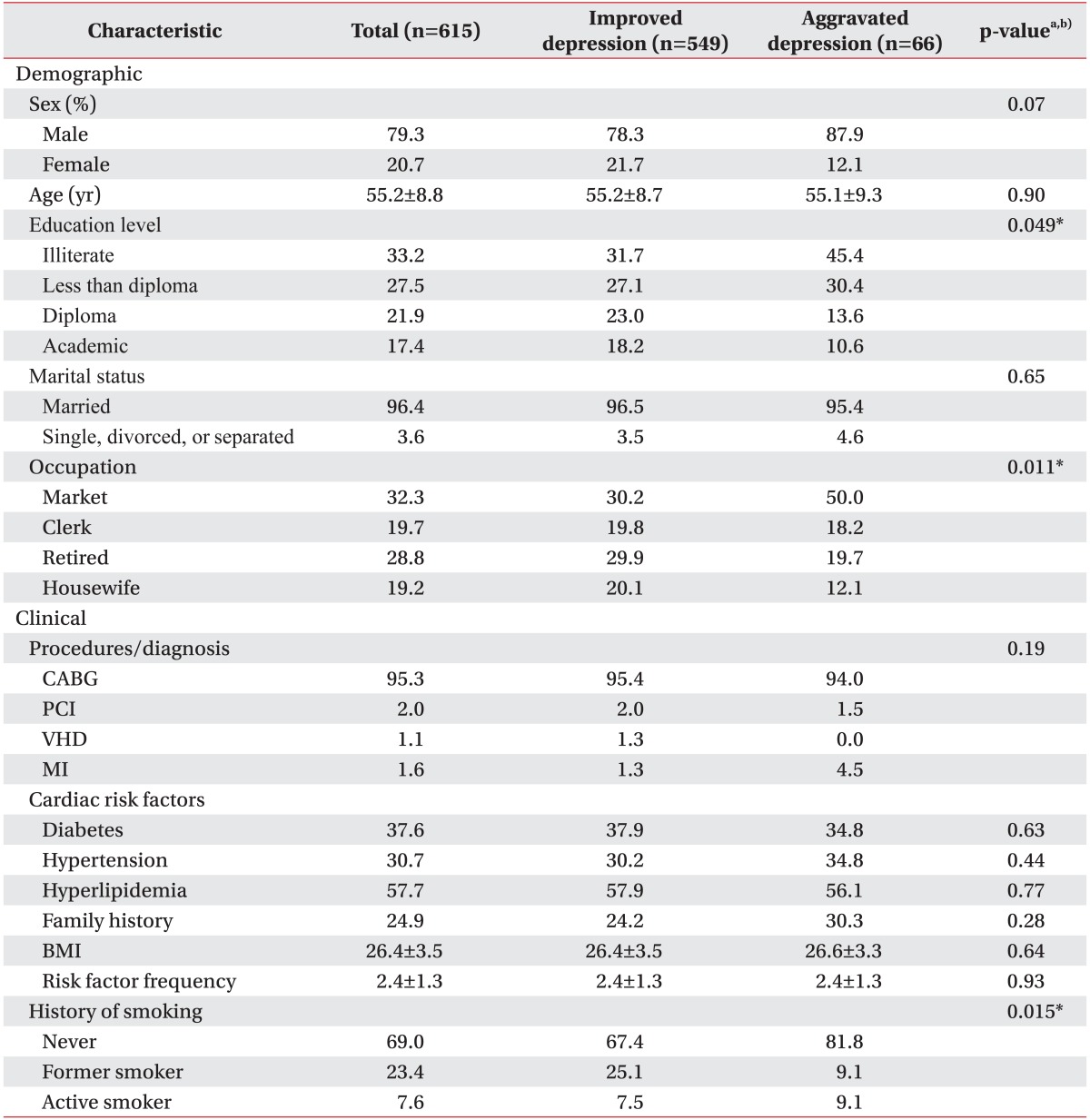1. Vaccarino V, Bremner JD. Psychiatric and behavioral aspects of cardiovascular disease. In: Bonow RO, Mann DL, Zipes DP, Libby P, editors. Braunwald's Heart disease: a text book of cardiovascular medicine. 9nd ed. Philadelphia: Saunders; 2012. p.1904-1915.
2. Chauvet-Gelinier JC, Trojak B, Verges-Patois B, Cottin Y, Bonin B. Review on depression and coronary heart disease. Arch Cardiovasc Dis 2013;106:103-110. PMID:
23527914.


3. Goldston K, Baillie AJ. Depression and coronary heart disease: a review of the epidemiological evidence, explanatory mechanisms and management approaches. Clin Psychol Rev 2008;28:288-306. PMID:
17601644.


4. Chien CL, Lee CM, Wu YW, Wu YT. Home-based exercise improves the quality of life and physical function but not the psychological status of people with chronic heart failure: a randomised trial. J Physiother 2011;57:157-163. PMID:
21843830.

5. Saeidi M. The efficacy methods of relaxation and reconstruction of cognitive on anxiety and depression in cardiac rehabilitation patients [master's thesis]. Tehran: Tehran Psychiatry Institute; 2004.
6. Karami J, Komasi S, Maesoomi M, Saeidi M. Comparing the effects of two methods of relaxation and interpersonal cognitive problem solving (ICPS) on decreasing anxiety and depression in cardiac rehabilitation patients. Urmia Med J 2014;25:298-308.
7. Capistrant BD, Gilsanz P, Moon JR, Kosheleva A, Patton KK, Glymour MM. Does the association between depressive symptoms and cardiovascular mortality risk vary by race? Evidence from the Health and Retirement Study. Ethn Dis 2013;23:155-160. PMID:
23530295.


8. Elderon L, Whooley MA. Depression and cardiovascular disease. Prog Cardiovasc Dis 2013;55:511-523. PMID:
23621961.


9. Saeidi M, Komasi S, Soroush A, Zakiei A, Shakeri J. Gender differences in patients' beliefs about biological, environmental, behavioral, and psychological risk factors in a cardiac rehabilitation program. J Cardiothorac Med 2014;2:215-220.
10. Saeidi M, Soroush A, Komasi S, Momeni K, Heydarpour B. Attitudes toward cardiovascular disease risk factors among patients referred to a cardiac rehabilitation center: importance of psychological attitudes. Shiraz E Med J 2015;16:e22281.

11. Sher L. Psychological factors and cardiovascular disorders: the role of stress and psychological influences. New York: Nova Biomedical Books; 2009. p.83-97.
12. Soroush A, Heydarpour B, Saeidi M, Komasi S, Ezzati P, Rashidi AA. Cardiac disease risk factors in cardiac rehabilitation patients with and without depression In: Proceedings of the 1st International Congress of Cardiac Rehabilitation; 2014 Oct 21-23; Isfahan, Iran.
13. Bath J, Bohin G, Jones C, Scarle E. Cardiac rehabilitation: a workbook for use with group programmes. Chichester: John Wiley & Sons; 2009.
14. World Health Organization. Needs and action priorities in cardiac rehabilitation and secondary prevention in patients with coronary heart disease. Geneva: World Health Organization; 1993.
15. Williams MA, Ades PA, Hamm LF, Keteyian SJ, La-Fontaine TP, Roitman JL, et al. Clinical evidence for a health benefit from cardiac rehabilitation: an update. Am Heart J 2006;152:835-841. PMID:
17070142.


16. Milani RV, Lavie CJ. Impact of cardiac rehabilitation on depression and its associated mortality. Am J Med 2007;120:799-806. PMID:
17765050.


17. Beck AT, Epstein N, Brown G, Steer RA. An inventory for measuring clinical anxiety: psychometric properties. J Consult Clin Psychol 1988;56:893-897. PMID:
3204199.



18. Ghasemzadeh A, Ghasemzadeh I, Zare Shahri R, Namazi SS, Namazi SA. Prevalence of depression among patients with coronary artery disease and associated factors. Life Sci J 2014;11:240-243.
19. Miech RA, Shanahan MJ. Socioeconomic status and depression over the life course. J Health Soc Behav 2000;41:162-176.

20. Allan JL, Johnston DW, Johnston M, Mant D. Depression and perceived behavioral control are independent predictors of future activity and fitness after coronary syndrome events. J Psychosom Res 2007;63:501-508. PMID:
17980223.


21. Moser DK, Dracup K. Psychosocial recovery from a cardiac event: the influence of perceived control. Heart Lung 1995;24:273-280. PMID:
7591794.


22. Mykletun A, Overland S, Aaro LE, Liabo HM, Stewart R. Smoking in relation to anxiety and depression: evidence from a large population survey: the HUNT study. Eur Psychiatry 2008;23:77-84. PMID:
18082377.


23. Hasan U, Nasreen R. Cognitive dissonance and its impact on consumer buying behaviour. IOSR J Bus Manag 2012;1:7-12.

24. Burns JW, Kubilus A, Bruehl S, Harden RN, Lofland K. Do changes in cognitive factors influence outcome following multidisciplinary treatment for chronic pain? A cross-lagged panel analysis. J Consult Clin Psychol 2003;71:81-91. PMID:
12602428.



25. Smallheer BA. Learned helplessness and depressive symptoms in patients following acute myocardial infarction [dissertation]. Nashville: Vanderbilt University; 2011.










